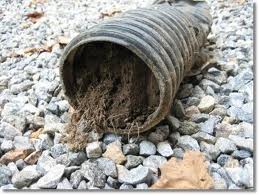
This perforated pipe was not adequately protected and dirt, silt and roots blocked in a short period.
- Water will find its way in if there is a way in.
- Water will take the path of least resistance.
- Water will pool at a low spot.
- Water will flow down hill.
- Will it stop the water from coming in?
- Will it keep water out?
- Will it direct water away?
- Will the water flow downward?
- Will the water stay way?



